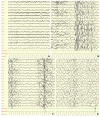EEG Features in Autism Spectrum Disorder: A Retrospective Analysis in a Cohort of Preschool Children
- PMID: 36831889
- PMCID: PMC9954463
- DOI: 10.3390/brainsci13020345
EEG Features in Autism Spectrum Disorder: A Retrospective Analysis in a Cohort of Preschool Children
Abstract
Autism Spectrum Disorder (ASD) is a complex neurodevelopmental disorder that can be associated with intellectual disability (ID) and epilepsy (E). The etiology and the pathogenesis of this disorder is in most cases still to be clarified. Several studies have underlined that the EEG recordings in children with these clinical pictures are abnormal, however the precise frequency of these abnormalities and their relationship with the pathogenic mechanisms and in particular with epileptic seizures are still unknown. We retrospectively reviewed 292 routine polysomnographic EEG tracings of preschool children (age < 6 years) who had received a first multidisciplinary diagnosis of ASD according to DSM-5 clinical criteria. Children (mean age: 34.6 months) were diagnosed at IRCCS E. Medea (Bosisio Parini, Italy). We evaluated: the background activity during wakefulness and sleep, the presence and the characteristics (focal or diffuse) of the slow-waves abnormalities and the interictal epileptiform discharges. In 78.0% of cases the EEG recordings were found to be abnormal, particularly during sleep. Paroxysmal slowing and epileptiform abnormalities were found in the 28.4% of the subjects, confirming the high percentage of abnormal polysomnographic EEG recordings in children with ASD. These alterations seem to be more correlated with the characteristics of the underlying pathology than with intellectual disability and epilepsy. In particular, we underline the possible significance of the prevalence of EEG abnormalities during sleep. Moreover, we analyzed the possibility that EEG data reduces the ASD clinical heterogeneity and suggests the exams to be carried out to clarify the etiology of the disorder.
Keywords: EEG; autism; epileptiform abnormalities; paroxysmal abnormalities; sleep.
Conflict of interest statement
The authors declare no conflict of interest.
Figures





References
-
- Maj M.M., Massimo B. DSM-5®: Manuale Diagnostico e Statistico dei Disturbi Mentali. 5th ed. R. Cortina; Milano, Italy: 2014. in print .
-
- Centers for Disease Control and Prevention. [(accessed on 23 December 2022)]; Available online: https://www.cdc.gov/ncbddd/autism/data.html.
-
- Narzisi A., Posada M., Barbieri F., Chericoni N., Ciuffolini D., Pinzino M., Romano R., Scattoni M.L., Tancredi R., Calderoni S., et al. Prevalence of Autism Spectrum Disorder in a large Italian catchment area: A school-based population study within the ASDEU project. Epidemiol. Psychiatr. Sci. 2018;29:e5. doi: 10.1017/S2045796018000483. - DOI - PMC - PubMed
LinkOut - more resources
Full Text Sources

